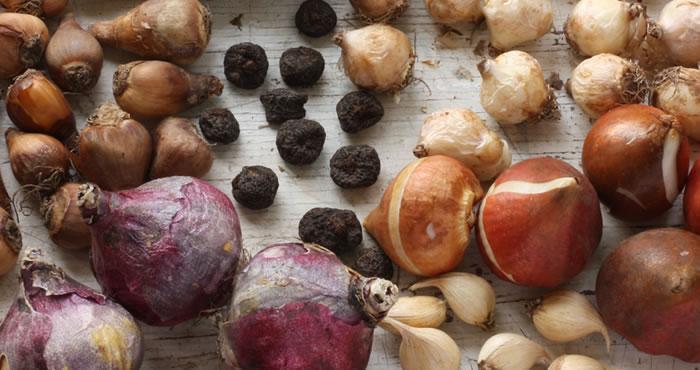Southwest Yard & Garden – Growing Beautiful Bulbs Can Be a Breeze


Bulb montage from Suzy Andrego’s beautiful garden last March. Photo credits M. Thompson.
Question: My friend recently gave me a bag of mixed bulbs to try in my yard. She assured me they’ll be easy to plant and manage, but I’m afraid of killing them before they even have a chance. What are the most important tips for growing bulbs here, and how can I know if I’m doing it right or not?
- Suzanne S., Las Cruces
Answer: Don’t worry, I’ve simplified the steps for bulb planting in this column and included pro tips from a regionally revered gardener. You’ll know you’re doing it right when the plants sprout and blooms open. Daffodils became my new favorite flower after blooming on my birthday several years in a row in Las Cruces (February 7, if you must know). And if you do it wrong, you’ll likely never even see the bulb sprout, so they’ll be easy to forget.
Because you have a mixed bag of bulbs, we don’t know exactly where to place them, so I recommend splitting them into two groups and planting half in a sunny, warm spot and the other half in a spot that’s a little cooler and might get partial shade. If you’re not well acquainted with the microclimates in your yard, think back to the last time it snowed (or find photos of your winter wonderland yard from years past). Areas where the snow first melted are likely the warm microclimates, and spots where snow stayed for way too long are probably the coldest microclimates. I can guess at where these spots are in my new yard, but I’m planning to ask Santa for more garden thermometers so I can track the microclimates precisely this winter.
Even more important than microclimate when identifying the perfect place for your bulbs is picking a place you’ll notice. That way you’re less likely to miss the bloom time altogether and less likely to forget to water them. Don’t ask me how I came up with that last tip. I’d rather not say, but I will quote Rita Mae Brown, “Good judgment comes from experience, and experience comes from bad judgment.”
One rule of (green) thumb is to plant bulbs two to three times as deep as the bulb is tall. In the past, I’ve cheated a little in stubborn soil by planting daffodils with the tip barely peeking above the soil and still gotten beautiful blooms, but the general consensus is to quit with the laziness and plant them at the recommended depths. More on this from a more experienced bulb planter later.
You can excavate holes for each bulb individually with a specialized tool that’s good at irritating wrists, or dig and loosen a larger portion of soil using a regular shovel or trowel.
And here’s the best part. Avoid over-watering before flower buds emerge. Water the bulb zone after planting and maybe again in a week or so, especially in sandier or rockier soils, and then back off. This is the real reason daffodils stole my heart: incredibly low water requirements. Once blooms and foliage emerge, a little more water is necessary to ensure the plant stays green and healthy after flowering so it can successfully create and store carbohydrates for next year’s show.
As usual, mulching with a few inches of woodchips, leaves, or the like helps maintain moisture, mediate soil temperatures, and keep weeds down.
Garden club members all over the state know that Suzy Andrego is a bulb guru. Last January, I attended one of her lectures and gathered these pearls of wisdom:
- Plant bulbs any time (except when the ground is frozen)! Get them in the ground as soon as possible because they’re better off there than on a shelf in your garage.
- Planting depth: four times the bulb height [if you can muster the strength] for even better performance year after year. In the long run, it’ll be worth the extra effort.
- Layer bulbs with different bloom times in a single hole for planting and watering ease.
- Except for tulips, it’s ok to plant many bulbs upside-down, just get them in the ground!
Let us know how many blooms you get in 2020. Better yet, share photos with us on social media (@NMDesertBlooms) and then we can delve deeper into the bulb world, including their benefits and how to encourage even better results in future years.
For more gardening information, including decades of archived Southwest Yard & Garden columns, visit the NMSU Extension Horticulture page (http://desertblooms.nmsu.edu/), follow us on social media (@NMDesertBlooms), or contact your County Extension office (https://aces.nmsu.edu/county).
Marisa Thompson, PhD, is the Extension Horticulture Specialist for New Mexico State University and is based at the Agricultural Science Center at Los Lunas.
